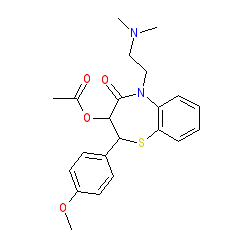|
Synonyms: [3H]-(+)-cis-diltiazem
Compound class:
Synthetic organic
Ligand Activity Visualisation ChartsThese are box plot that provide a unique visualisation, summarising all the activity data for a ligand taken from ChEMBL and GtoPdb across multiple targets and species. Click on a plot to see the median, interquartile range, low and high data points. A value of zero indicates that no data are available. A separate chart is created for each target, and where possible the algorithm tries to merge ChEMBL and GtoPdb targets by matching them on name and UniProt accession, for each available species. However, please note that inconsistency in naming of targets may lead to data for the same target being reported across multiple charts. ✖ |
|
|||||||||||||||||||||||||||||||||||
| References |
|
1. Hagiwara M, Adachi-Akahane S, Nagao T. (1997)
High-affinity binding of DTZ323, a novel derivative of diltiazem, to rabbit skeletal muscle L-type Ca++ channels. J Pharmacol Exp Ther, 281 (1): 173-9. [PMID:9103495] |
|
2. Nokin P, Clinet M, Beaufort P, Meysmans L, Laruel R, Chatelain P. (1990)
SR 33557, a novel calcium entry blocker. II. Interactions with 1,4-dihydropyridine, phenylalkylamine and benzothiazepine binding sites in rat heart sarcolemmal membranes. J Pharmacol Exp Ther, 255 (2): 600-7. [PMID:2147036] |
|
3. Prinz H, Striessnig J. (1993)
Ligand-induced accelerated dissociation of (+)-cis-diltiazem from L-type Ca2+ channels is simply explained by competition for individual attachment points. J Biol Chem, 268 (25): 18580-5. [PMID:8395510] |









